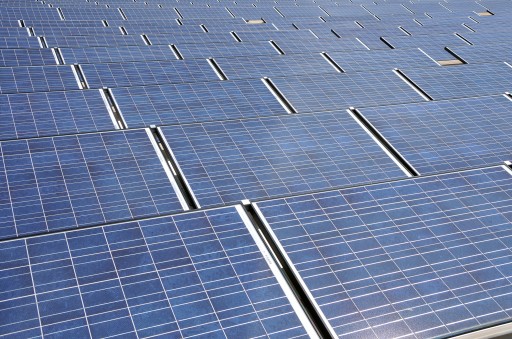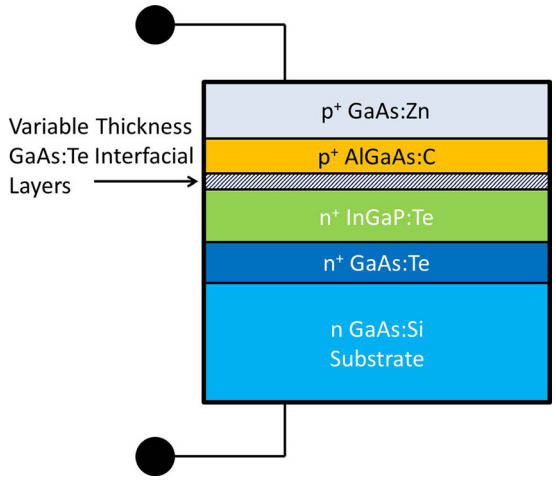New junction between stacked solar cells can handle max energy of 70,000 suns
September 10, 2013

Solar cell manufacturers can now create stacked solar cells that can handle high-intensity solar energies without losing voltage at the connecting junctions, potentially improving conversion efficiency (credit: NC State University)
North Carolina State University researchers have come up with a new technique for improving the connections between stacked solar cells, which should improve the overall efficiency of solar energy devices and reduce the cost of solar energy production, the researchers say.
The new connections can allow these cells to operate at theoretical solar concentrations of 70,000 “suns”* worth of energy without losing much voltage as “wasted energy” or heat. (In practice, a maximum of about 5,000 suns is available with available concentrating lenses.)
Stacked solar cells consist of several solar cells that are stacked on top of one another. Stacked cells are currently the most efficient cells on the market, converting up to 45 percent of the solar energy they absorb into electricity.
But to be effective, solar cell designers need to ensure the connecting junctions between these stacked cells do not absorb any of the solar energy and do not siphon off the voltage the cells produce — effectively wasting that energy as heat.

Added gallium arsenide layer eliminates voltage loss (credit: NC State University/Appl. Phys. Lett.)
Adding gallium arsenide film eliminates voltage loss
“We have discovered that by inserting a very thin film of gallium arsenide into the connecting junction of stacked cells we can virtually eliminate voltage loss (only a few mV across the junction) without blocking any of the solar energy,” says Dr. Salah Bedair, a professor of electrical engineering at NC State and senior author of a paper describing the work.
This work is important because photovoltaic energy companies are interested in using lenses to concentrate solar energy, from one sun (no lens) to 4,000 suns or more.
But if the solar energy is significantly intensified — to 700 suns or more — the connecting junctions used in existing stacked cells begin losing voltage. And the more intense the solar energy, the more voltage those junctions lose — thereby reducing the conversion efficiency.
“Now we have created a connecting junction that loses almost no voltage, even when the stacked solar cell is exposed to 70,000 suns of solar energy,” Bedair says. “And that is more than sufficient for practical purposes, since concentrating lenses are unlikely to create more than 4,000 or 5,000 suns worth of energy. This discovery means that solar cell manufacturers can now create stacked cells that can handle these high-intensity solar energies without losing voltage at the connecting junctions, thus potentially improving conversion efficiency.
Reducing costs
“This should reduce overall costs for the energy industry because, rather than creating large, expensive solar cells, you can use much smaller cells that produce just as much electricity by absorbing intensified solar energy from concentrating lenses. And concentrating lenses are relatively inexpensive,” Bedair says.
The research was funded by the U.S. Department of Energy and the National Science Foundation.
* “‘Suns’ is a unit used by the solar concentrator community to express the degree of concentration of the mirror system, similar to the magnification factor of a lens. Note that this unit is not precisely defined.” (“Solar Power (Technology and Economics)), Electropedia. 1 sun= 1 kW per square meter (Monte Carlo Radiative Transfer Modeling of a Solar Chemical Reactor for The Co-Production of Zinc and Syngas, Transactions of the ASME, Feb. 2005), based on “irradiance at the Earth’s surface to approximately 1000 W /m2 for a surface perpendicular to the Sun’s rays at sea level on a clear day” (Wikipedia).
UPDATED Sept. 10, 2013 to define “suns”
